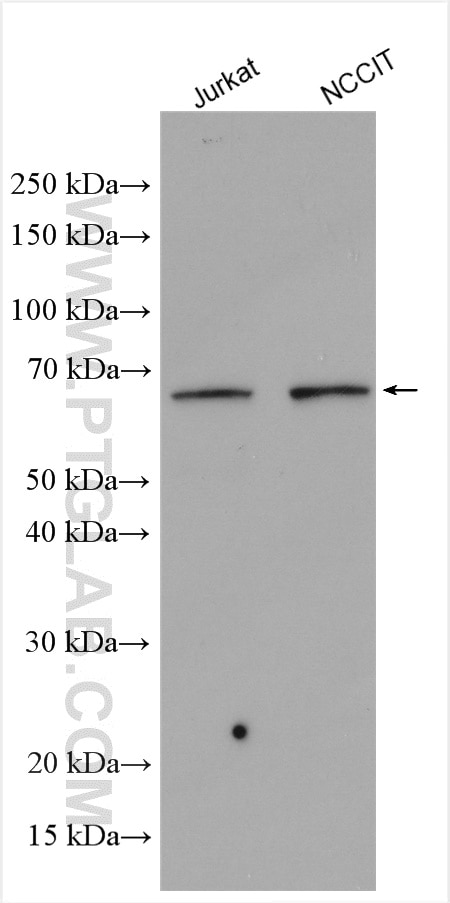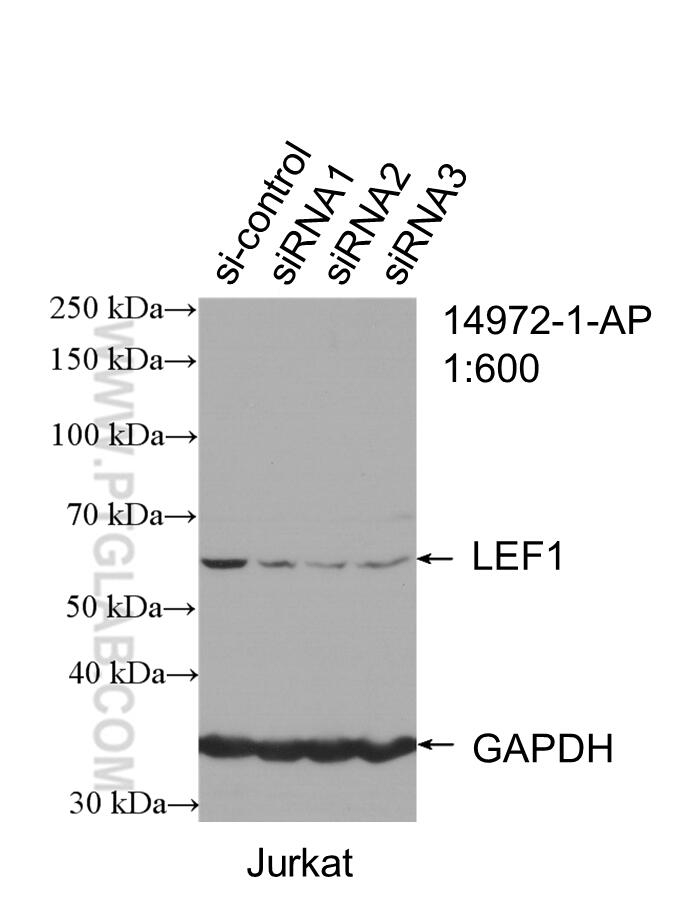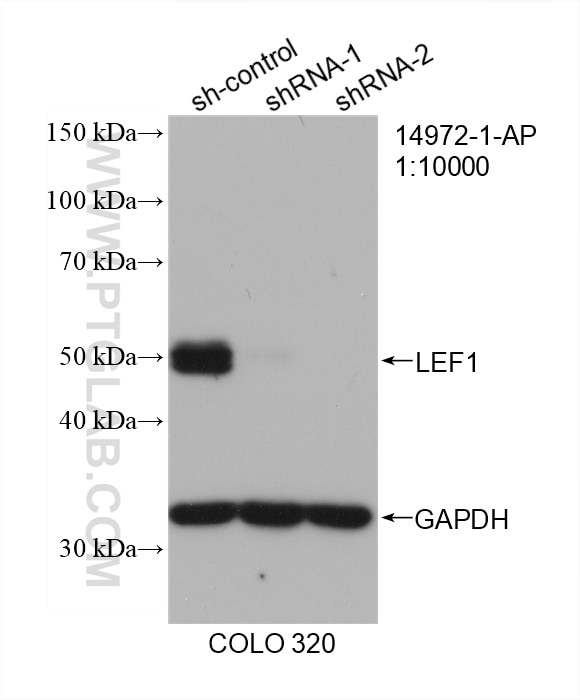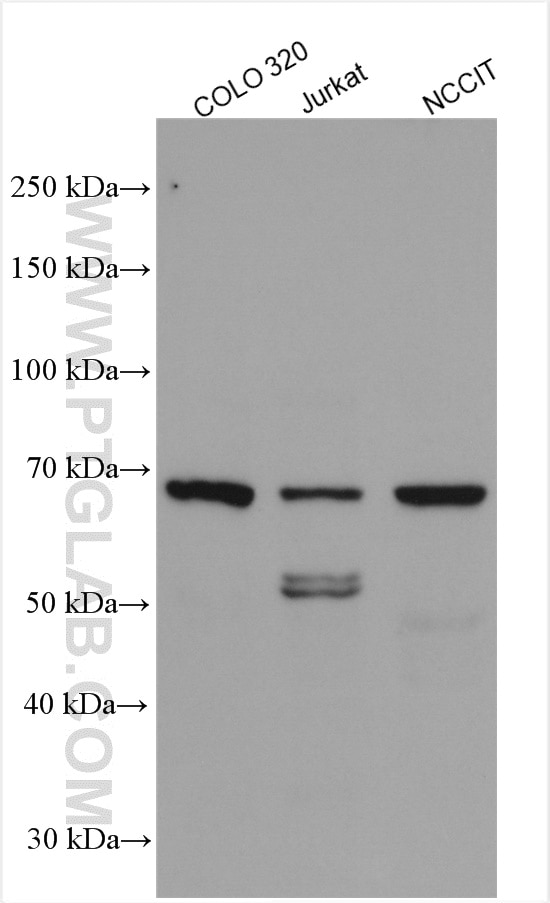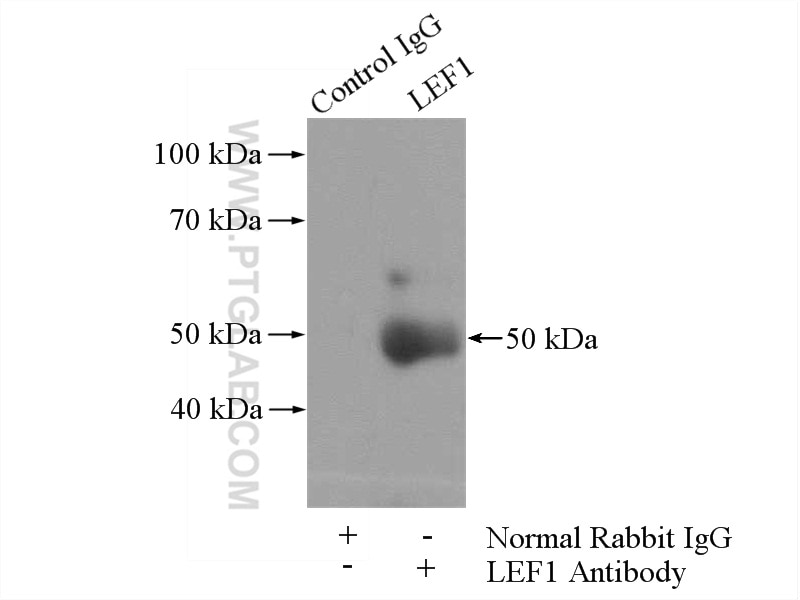Validation Data Gallery
Tested Applications
| Positive WB detected in | Jurkat cells, COLO 320 cells, NCCIT cells |
| Positive IP detected in | SW 1990 cells |
Recommended dilution
| Application | Dilution |
|---|---|
| Western Blot (WB) | WB : 1:1000-1:4000 |
| Immunoprecipitation (IP) | IP : 0.5-4.0 ug for 1.0-3.0 mg of total protein lysate |
| It is recommended that this reagent should be titrated in each testing system to obtain optimal results. | |
| Sample-dependent, Check data in validation data gallery. | |
Published Applications
| KD/KO | See 4 publications below |
| WB | See 48 publications below |
| IHC | See 8 publications below |
| IF | See 4 publications below |
| IP | See 1 publications below |
Product Information
14972-1-AP targets LEF1 in WB, IHC, IF, IP, ELISA applications and shows reactivity with human samples.
| Tested Reactivity | human |
| Cited Reactivity | human, mouse, rat, rabbit |
| Host / Isotype | Rabbit / IgG |
| Class | Polyclonal |
| Type | Antibody |
| Immunogen |
CatNo: Ag6882 Product name: Recombinant human LEF1 protein Source: e coli.-derived, PET28a Tag: 6*His Domain: 1-399 aa of BC050632 Sequence: MPQLSGGGGGGGGDPELCATDEMIPFKDEGDPQKEKIFAEISHPEEEGDLADIKSSLVNESEIIPASNGHEVARQAQTSQEPYHDKAREHPDDGKHPDGGLYNKGPSYSSYSGYIMMPNMNNDPYMSNGSLSPPIPRTSNKVPVVQPSHAVHPLTPLITYSDEHFSPGSHPSHIPSDVNSKQGMSRHPPAPDIPTFYPLSPGGVGQITPPLGWQGQPVYPITGGFRQPYPSSLSVDTSMSRFSHHMIPGPPGPHTTGIPHPAIVTPQVKQEHPHTDSDLMHVKPQHEQRKEQEPKRPHIKKPLNAFMLYMKEMRANVVAECTLKESAAINQILGRRWHALSREEQAKYYELARKERQLHMQLYPGWSARDNYGKKKKRKREKLQESASGTGPRMTAAYI 相同性解析による交差性が予測される生物種 |
| Full Name | lymphoid enhancer-binding factor 1 |
| Calculated molecular weight | 37 kDa |
| Observed molecular weight | 50-55 kDa, 65 kDa |
| GenBank accession number | BC050632 |
| Gene Symbol | LEF1 |
| Gene ID (NCBI) | 51176 |
| ENSEMBL Gene ID | ENSG00000138795 |
| RRID | AB_2265677 |
| Conjugate | Unconjugated |
| Form | |
| Form | Liquid |
| Purification Method | Antigen affinity purification |
| UNIPROT ID | Q9UJU2 |
| Storage Buffer | PBS with 0.02% sodium azide and 50% glycerol{{ptg:BufferTemp}}7.3 |
| Storage Conditions | Store at -20°C. Stable for one year after shipment. Aliquoting is unnecessary for -20oC storage. |
Background Information
Lymphoid enhancer-binding factor 1(LEF1) belongs to a family of regulatory proteins that share homology with high mobility group protein-1, and it's a nuclear protein expressed in pre-B and T cells. LEF1 has a role in the Wnt signaling pathway hair cell differentiation and follicle morphogenesis. Together with CTNNB1 and EP300, LEF1 activates transcription of target genes. Isoform 5 transcriptionally activates the fibronectin promoter, binds to and represses transcription from the E-cadherin promoter in a CTNNB1-independent manner, and is involved in reducing cellular aggregation and increasing cell migration of pancreatic cancer cells. Isoform 1 transcriptionally activates MYC and CCND1 expression and enhances the proliferation of pancreatic tumor cells. MECs can give rise to seven cell types of the SAE and SMGs following severe airway injury. MECs progressively adopted a basal cell phenotype on the SAE and established lasting progenitors capable of further regeneration following reinjury. MECs activate Wnt-regulated transcription factors (Lef-1/TCF7) following injury and Lef-1 induction in cultured MECs promotes transition to a basal cell phenotype. Surprisingly, dose-dependent MEC conditional activation of Lef-1in vivopromoted self-limited airway regeneration in the absence of injury. Thus, modulating the Lef-1 transcriptional program in MEC-derived progenitors may have regenerative medicine applications for lung diseases. (https://doi.org/10.1016/j.stem.2018.03.017) The phosphorylation may affect the LEF1 protein's theoretical molecular weight when tested.40-70 kD bands have also been reported (PMID: 22261717; 17063141 ).
Protocols
| Product Specific Protocols | |
|---|---|
| IP protocol for LEF1 antibody 14972-1-AP | Download protocol |
| WB protocol for LEF1 antibody 14972-1-AP | Download protocol |
| Standard Protocols | |
|---|---|
| Click here to view our Standard Protocols |
Publications
| Species | Application | Title |
|---|---|---|
Cell Mol Immunol TRIM27 maintains gut homeostasis by promoting intestinal stem cell self-renewal | ||
J Allergy Clin Immunol Dedicator of cytokinesis protein 2 couples with lymphoid enhancer-binding factor 1 to regulate expression of CD21 and B-cell differentiation. | ||
Cell Death Differ MACF1 promotes osteoblast differentiation by sequestering repressors in cytoplasm. | ||
Clin Cancer Res microRNA-221 Enhances MYCN via Targeting Nemo-like Kinase and Functions as an Oncogene Related to Poor Prognosis in Neuroblastoma. | ||
Cancer Lett TIMELESS confers cisplatin resistance in nasopharyngeal carcinoma by activating the Wnt/β-catenin signaling pathway and promoting the epithelial mesenchymal transition.
| ||
Cell Death Dis Inhibition of phosphodiesterase 5 reduces bone mass by suppression of canonical Wnt signaling. |

